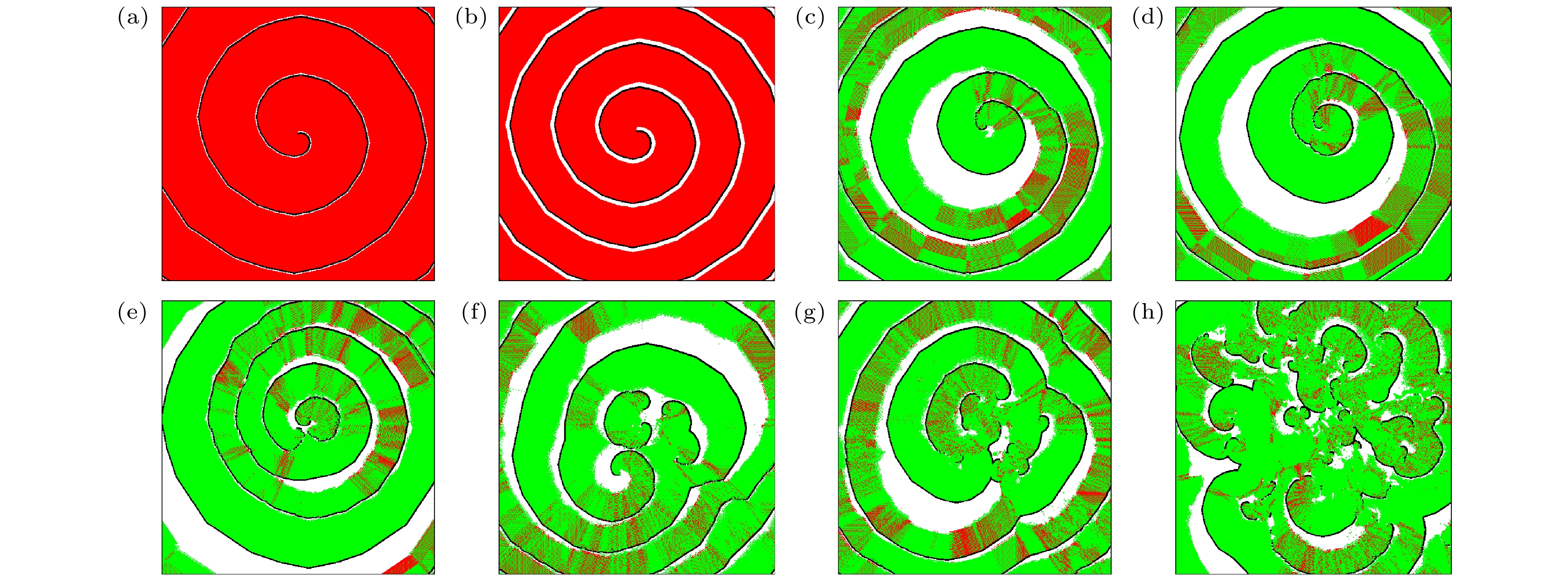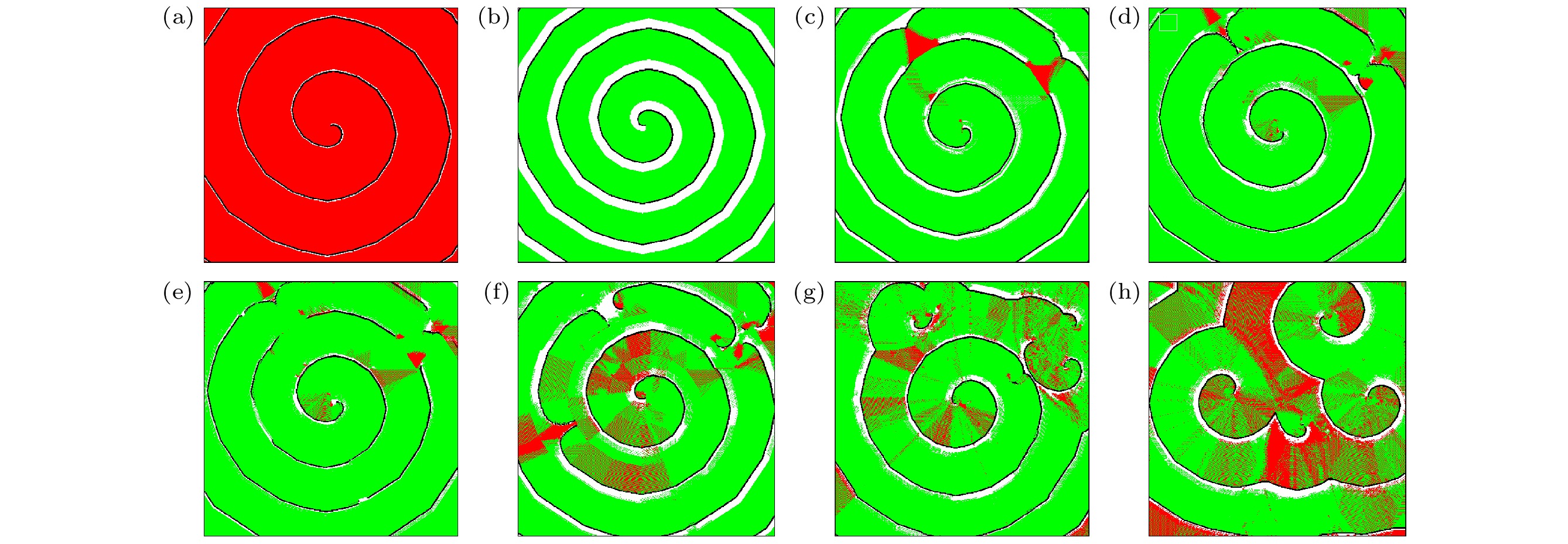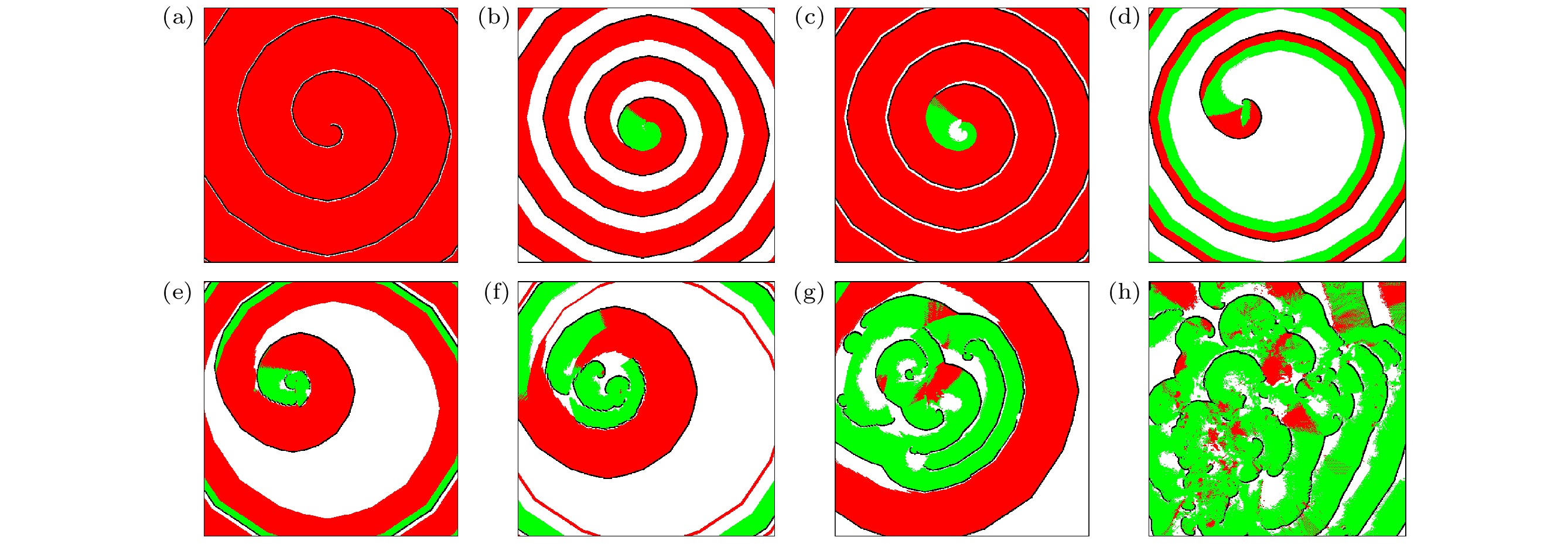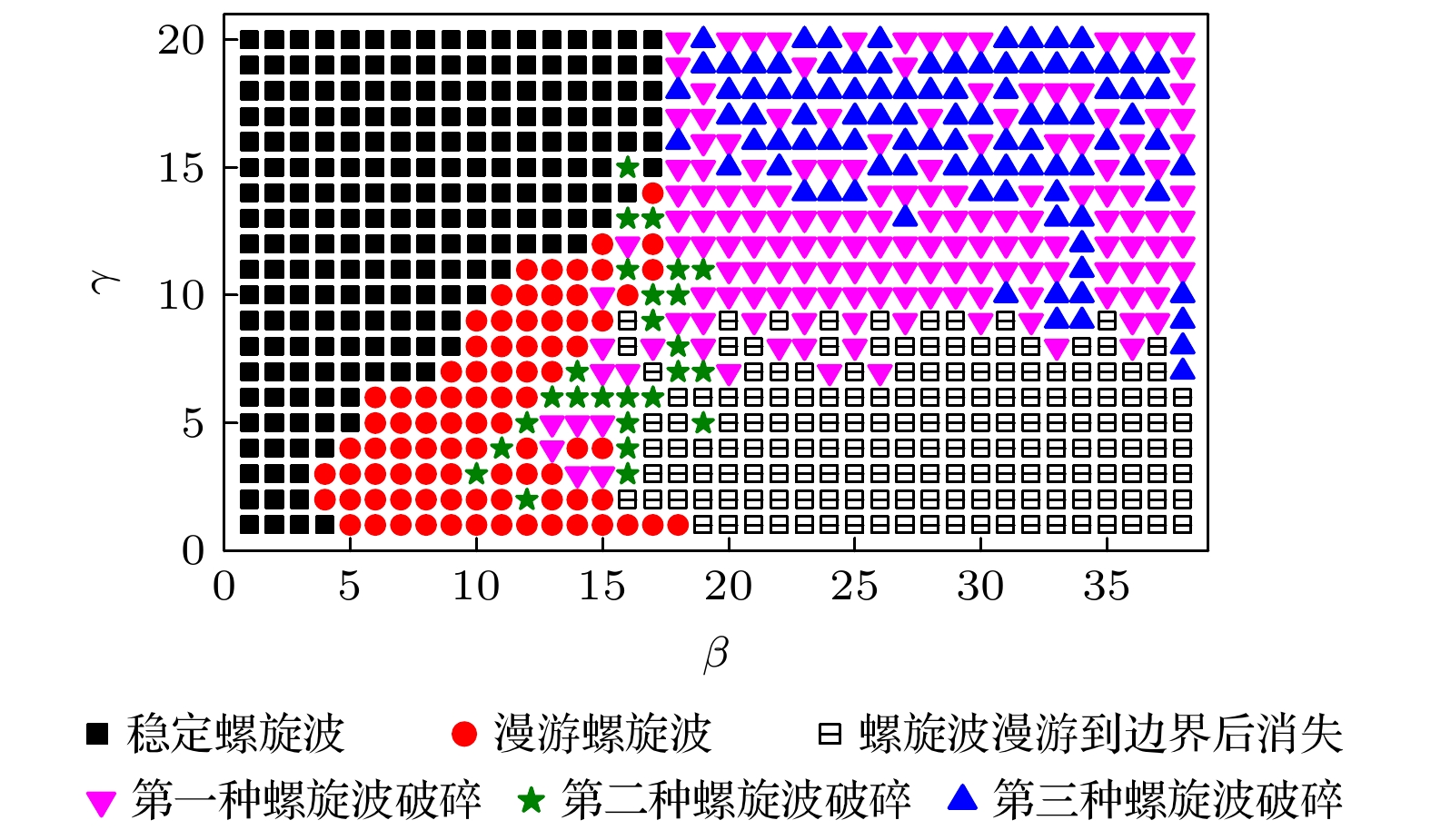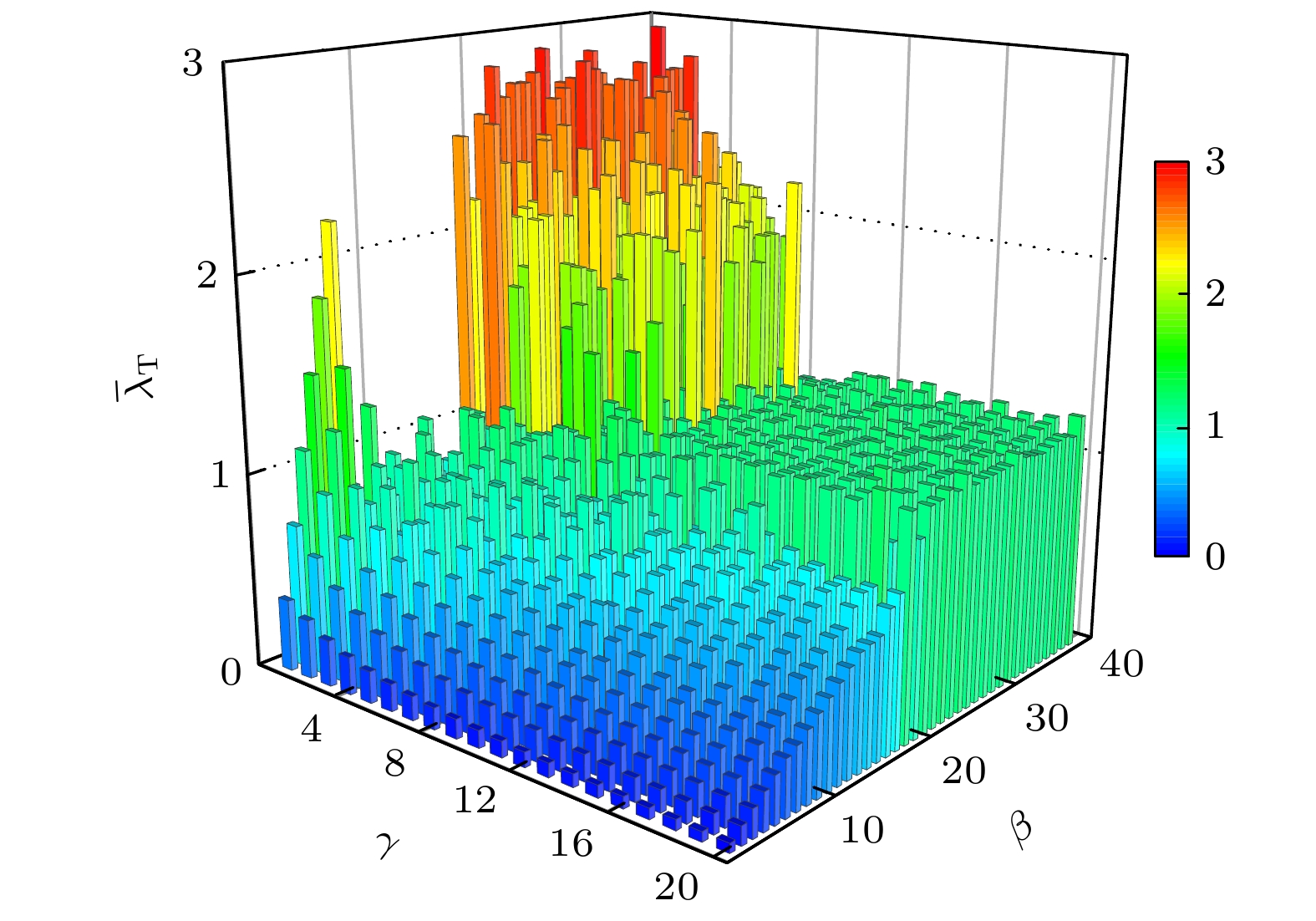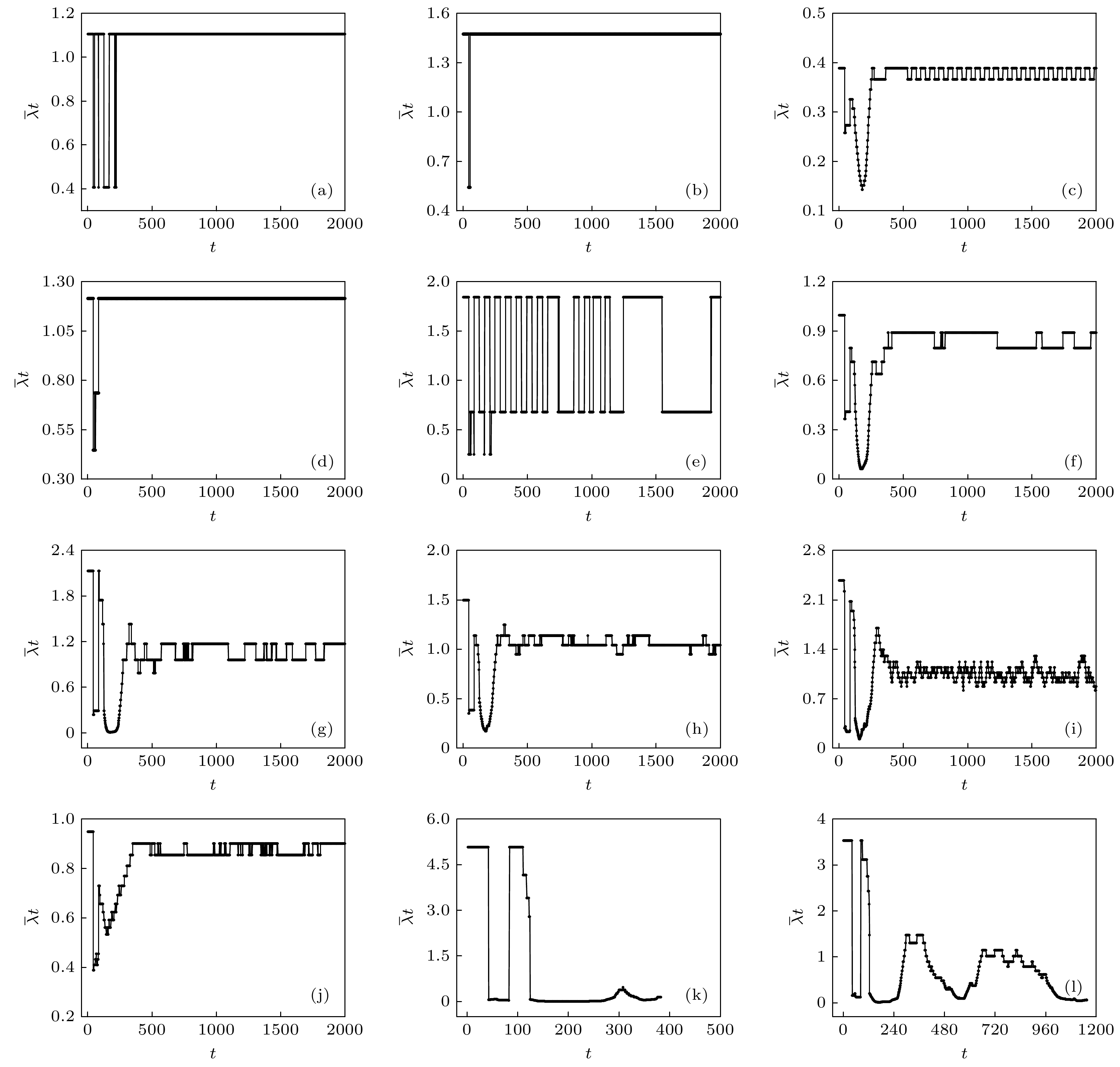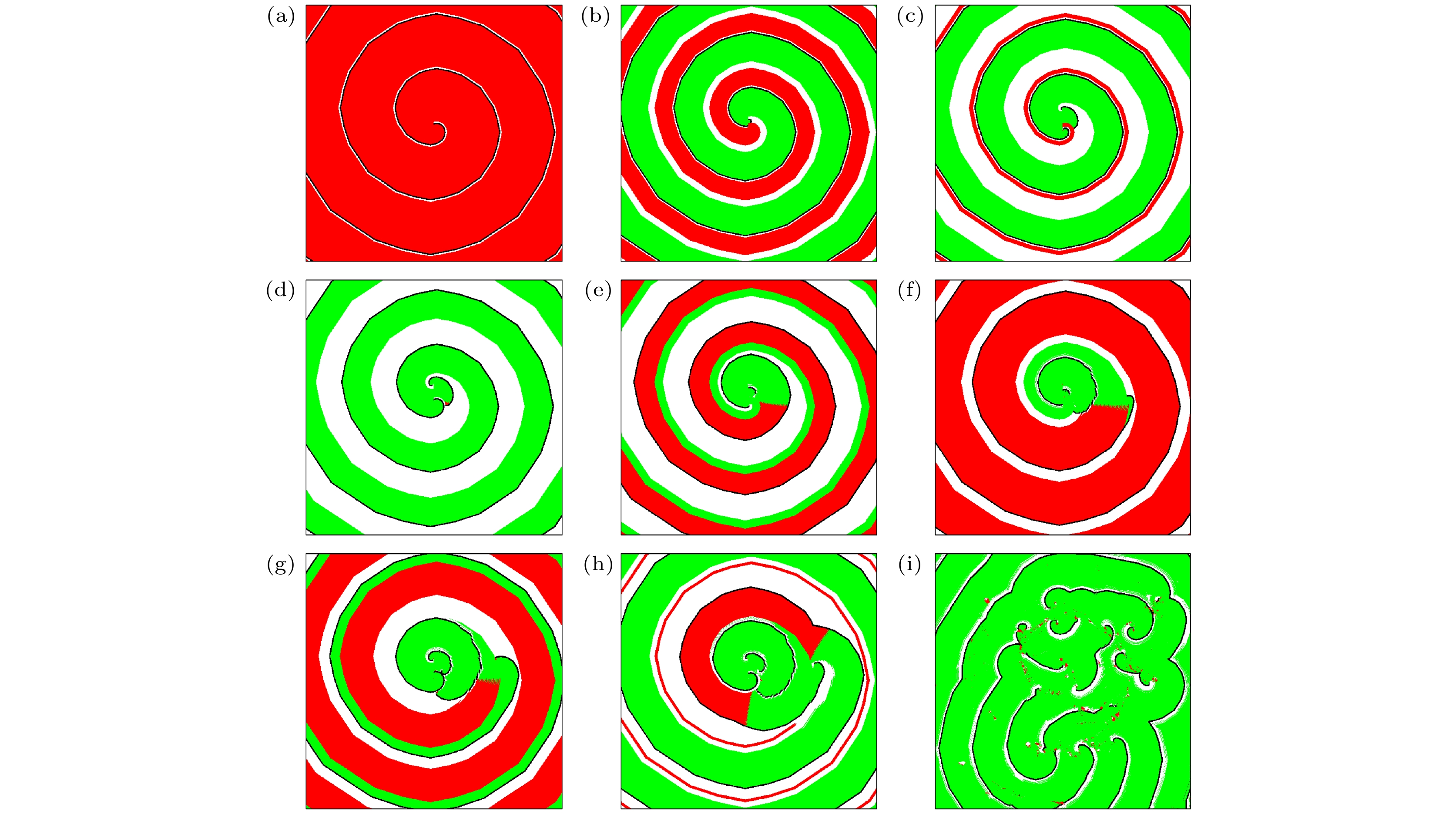-
It is observed in cardiac patients that the steepnesses of action potential duration (APD) restitution curve of cardiomyocytes in different regions of the ventricle are significantly different from region to region. However, the steep APD restitution curve can either lead the spiral wave to break up and set up the ventricular fibrillation in certain conditions or result in no breakup of spiral wave in other conditions. The relationship between the dynamic behavior of spiral wave and steep APD restitution curve is still not completely clear. Therefore, further research is needed. In this paper, a two-dimensional excitable medium cellular automata model is used to study the influences of the APD restitution curves with different steepnesses on the dynamic behavior of spiral wave. Numerical simulation results show that the steep APD restitution curve can stabilize the meandering spiral wave, causing the stable spiral wave to roam or break, and even to disappear. When the total average slope of APD restitution curve is greater than 1, it is observed that spiral wave may be still stable or meandering. When the total average slope of APD restitution curve is much smaller than 1, the breakup of spiral waves may occur. Three types of spiral wave breakups are observed. They are the Doppler instability, Eckhaus instability, and APD alternation. The Doppler instability and Eckhaus instability are related to the total average slope of APD restitution curve greater than 1, and the spiral wave breakup caused by APD alternans may occur when the total average slope of APD restitution curve is much smaller than 1. When the total average slope of APD restitution curve is greater than 1, the phenomena that spiral waves disappear by meandering out of the system boundary and conduction barriers are observed. In addition, we also find that increasing cellular APD is beneficial to preventing spiral wave from breaking up. The physical mechanisms behind those phenomena are heuristically analyzed.
[1] Cross M C, Hohenberg P C 1993 Rev. Mod. Phys. 65 851
 Google Scholar
Google Scholar
[2] Frisch T, Rica S, Coullet P, Gilli J M 1994 Phys. Rev. Lett. 72 1471
 Google Scholar
Google Scholar
[3] Winfree A T 1972 Science 175 634
 Google Scholar
Google Scholar
[4] Gorelova N A, Bures J 1983 J. Neurobiol. 14 353
 Google Scholar
Google Scholar
[5] Huang X, Xu W, Liang J, Takagaki K, Gao X, Wu J Y 2010 Neuron 68 978
 Google Scholar
Google Scholar
[6] Pandit S V, Jalife J 2013 Circ. Res. 112 849
 Google Scholar
Google Scholar
[7] Narayan S M, Krummen D E, Rappel W J 2012 J. Cardiovasc. Electr. 23 447
 Google Scholar
Google Scholar
[8] Lip G Y H, Fauchier L, Freedman S B, Gelder I V, Natale A, Gianni C, Nattel S, Potpara T, Rienstra M, Tse H F, Lane D A 2016 Nat. Rev. Dis. Primers 2 16016
 Google Scholar
Google Scholar
[9] Gray R A, Jalife J, Panfilov A V, Baxter W T, Cabo C, Davidenko J M, Pertsov A M 1995 Science 270 1222
 Google Scholar
Google Scholar
[10] Christoph J, Chebbok M, Richter C, Schetelig J S, Bittihn P, Stein S, Uzelac I, Fenton F H 2018 Nature 555 667
 Google Scholar
Google Scholar
[11] Davidenko J M, Pertsov A V, Salomonsz R, Baxter W, Jalife J 1992 Nature 355 349
 Google Scholar
Google Scholar
[12] Kinoshita S, Iwamoto M, Tateishi K, Suematsu N J, Ueyama D 2013 Phys. Rev. E 87 062815
 Google Scholar
Google Scholar
[13] Luther S, Fenton F H, Kornreich B G, Squires A, Bittihn P, Hornung D 2011 Nature 475 235
 Google Scholar
Google Scholar
[14] 潘军廷, 何银杰, 夏远勋, 张宏 2020 物理学报 69 080503
 Google Scholar
Google Scholar
Pan J T, He Y J, Xia Y X, Zhang H 2020 Acta Phys. Sin. 69 080503
 Google Scholar
Google Scholar
[15] Fenton F H, Cherry E M, Hastings H M, Evans S J 2002 Chaos 12 852
 Google Scholar
Google Scholar
[16] Ng G A 2017 Pharmacol. Therapeut. 176 1
 Google Scholar
Google Scholar
[17] Rosenbaum D S, Kaplan D T, Kanai A, Jackson L, Garan H, Cohen R J, Salama G 1991 Circulation 84 1333
 Google Scholar
Google Scholar
[18] Banville I, Gray R A 2002 J. Cardiovasc. Elect. 13 1141
 Google Scholar
Google Scholar
[19] Berger R D 2004 Circ. Res. 94 567
 Google Scholar
Google Scholar
[20] Qu Z, Weiss J N 2015 Annu. Rev. Physiol. 77 29
 Google Scholar
Google Scholar
[21] Vandersickel N, Defauw A, Dawyndt P, Panflov A V 2016 Sci. Rep. 6 29397
 Google Scholar
Google Scholar
[22] Avula U M R, Abrams J, Katchman A, Zakharov S, Mironov S, Bayne J, Roybal D, Gorti A 2019 Jci Insight 5 e128765
 Google Scholar
Google Scholar
[23] Handa B S, Lawal S, Wright I J, Li X, García J C, Mansfield C, Chowdhury R A, Peters N S 2019 Front. Cardiovasc. Med. 6 34
 Google Scholar
Google Scholar
[24] Zheng Y, Wei D, Zhu X, Chen W, Fukuda K, Shimokawa H 2015 Comput. Biol. Med. 63 261
 Google Scholar
Google Scholar
[25] Garfinkel A, Kim Y H, Voroshilovsky O, Qu Z, Kil J R, Lee M H, Karagueuzian H S, Weiss J N, Chen P S 2000 Proc. Natl. Acad. Sci. U. S. A. 97 6061
 Google Scholar
Google Scholar
[26] Zhang N, Luo Q, Jin Q, Han Y, Huang S, Wei Y, Lin C, Chen K, Shen W, Wu L 2020 Cardiovasc. Drugs Ther. 34 323
 Google Scholar
Google Scholar
[27] Qu Z, Garfinkel A, Chen P S, Weiss J N 2000 Circulation 102 1664
 Google Scholar
Google Scholar
[28] Franz M R, Jamal S M, Narayan S M 2012 Europace 14 v58
 Google Scholar
Google Scholar
[29] Alonso S, Bär M, Echebarria B 2016 Rep. Prog. Phys. 79 096601
 Google Scholar
Google Scholar
[30] Clayton R H, Taggart P 2005 Biomed. Eng. Online 4 54
 Google Scholar
Google Scholar
[31] Nash M P, Bradley C P, Sutton P M, Clayton R H, Kallis P, Hayward M P, Paterson D J, Taggart P 2006 Exp. Physiol. 91 339
 Google Scholar
Google Scholar
[32] Bub G, Shrier A, Glass L 2005 Phys. Rev. Lett. 94 028105
 Google Scholar
Google Scholar
[33] Deng M Y, Dai J Y, Zhang X L 2015 Chin. Phys. B 24 090503
 Google Scholar
Google Scholar
[34] 张学良, 谭惠丽, 唐国宁, 邓敏艺 2017 物理学报 66 200501
 Google Scholar
Google Scholar
Zhang X L, Tan H L, Tang G N, Deng M Y 2017 Acta Phys. Sin. 66 200501
 Google Scholar
Google Scholar
[35] Lin Y T, Chang E T Y, Eatock J, Galla T, Clayton R H 2017 J. R. Soc. Interface 14 20160968
 Google Scholar
Google Scholar
[36] Pak H N, Hong S J, Hwang G S, Lee H S, Park S W 2004 J. Cardiovasc. Electr. 15 1357
 Google Scholar
Google Scholar
[37] 欧阳颀 2001 物理 30 30
Ouyang Q 2001 Physics 30 30
-
图 2 在参数
$ \alpha = 40 $ ,$ \gamma = 10 $ ,$ \beta = 14 $ 下不同时刻的膜电位斑图 (a)$ t = 0 $ ; (b)$ t = 20000 $ ; (c)$ t = 60000 $ ; (d)$ t = 100000 $ Figure 2. Patterns of the membrane potential at different time moments for
$ \alpha = 40 $ ,$ \gamma = 10 $ and$ \beta = 14 $ : (a)$ t = 0 $ ; (b)$ t = 20000 $ ; (c)$ t = 60000 $ ; (d)$ t = 100000 $ .图 3 在参数
$ \alpha = 40 $ ,$ \gamma = 10 $ ,$ \beta = 15 $ 下不同时刻的膜电位斑图, 白色代表静息态; 黑色代表激发态; 绿色(红色)代表元胞APD在[26, 30] ([31, 40])范围的不应态 (a)$ t = 0 $ ; (b)$ t = 400 $ ; (c)$ t = 490 $ ; (d)$ t = 510 $ ; (e)$ t = 560 $ ; (f)$ t = 1800 $ ; (g)$ t = 2000 $ ; (h)$ t = 3070 $ Figure 3. Patterns of the membrane potential at different time moments for
$ \alpha = 40 $ ,$ \gamma = 10 $ and$ \beta = 15 $ . The white and black represent the rest-state and excited state, respectively, the green (red) represents the refractory states in which the APD of the cell is in the range of [26,30] ([31, 40]): (a)$ t = 0 $ ; (b)$ t = 400 $ ; (c)$ t = 490 $ ; (d)$ t = 510 $ ; (e)$ t = 560 $ ; (f)$ t = 1800 $ ; (g)$ t = 2000 $ ; (h)$ t = 3070 $ .图 4 在参数
$ \alpha = 40 $ ,$ \gamma = 10 $ ,$ \beta = 18 $ 下不同时刻的膜电位斑图, 作图方式与图3一致 (a)$ t = 0 $ ; (b)$ t = 40 $ ; (c)$ t = 220 $ ; (d)$ t = 250 $ ; (e)$ t = 255 $ ; (f)$ t = 310 $ ; (g)$ t = 2850 $ ; (h)$ t = 34300 $ Figure 4. Patterns of the membrane potential at different time moments for
$ \alpha = 40 $ ,$ \gamma = 10 $ and$ \beta = 18 $ , the drawing method is consistent with Fig. 3: (a)$ t = 0 $ ; (b)$ t = 40 $ ; (c)$ t = 220 $ ; (d)$ t = 250 $ ; (e)$ t = 255 $ ; (f)$ t = 310 $ ; (g)$ t = 2850 $ ; (h)$ t = 34300 $ .图 5 在参数
$ \alpha = 40 $ ,$ \gamma = 10 $ ,$ \beta = 33 $ 下不同时刻的膜电位斑图, 作图方式与图3一致 (a)$ t = 0 $ ; (b)$ t = 50 $ ; (c)$ t = 60 $ ; (d)$t = $ $ 100$ ; (e)$ t = 130 $ ; (f)$ t = 150 $ ; (g)$ t = 200 $ ; (h)$ t = 500 $ Figure 5. Patterns of the membrane potential at different time moments for
$ \alpha = 40 $ ,$ \gamma = 10 $ and$ \beta = 33 $ , the drawing method is consistent with Fig. 3: (a)$ t = 0 $ ; (b)$ t = 50 $ ; (c)$ t = 60 $ ; (d)$ t = 100 $ ; (e)$ t = 130 $ ; (f)$ t = 150 $ ; (g)$ t = 200 $ ; (h)$ t = 500 $ .图 8 不同参数(螺旋波态)下恢复曲线的平均斜率随时间变化 (a)
$ \beta = 3 $ ,$ \gamma = 1 $ (稳定); (b)$ \beta = 4 $ ,$ \gamma = 1 $ (稳定); (c)$ \beta = 7 $ ,$ \gamma = 17 $ (稳定); (d)$ \beta = 4 $ ,$ \gamma = 2 $ (漫游); (e)$ \beta = 5 $ ,$ \gamma = 1 $ (漫游); (f)$ \beta = 10 $ ,$ \gamma = 9 $ (漫游); (g)$ \beta = 13 $ ,$ \gamma = 5 $ (第一种破碎); (h)$ \beta = 18 $ ,$ \gamma = 11 $ (第二种破碎); (i)$ \beta = 38 $ ,$ \gamma = 15 $ (第三种破碎); (j)$ \beta = 19 $ ,$ \gamma = 19 $ (总平均斜率小于1的破碎); (k)$ \beta = 31 $ ,$ \gamma = 5 $ (消失); (l)$ \beta = 32 $ ,$ \gamma = 8 $ (消失)Figure 8. Evolution of the average slope of the restitution curve for different parameters (spiral wave states): (a)
$ \beta = 3 $ ,$ \gamma = 1 $ (stable); (b)$ \beta = 4 $ ,$ \gamma = 1 $ (stable); (c)$ \beta = 7 $ ,$ \gamma = 17 $ (stable); (d)$ \beta = 4 $ ,$ \gamma = 2 $ (meandering); (e)$ \beta = 5 $ ,$ \gamma = 1 $ (meandering); (f)$ \beta = 10 $ ,$ \gamma = 9 $ (meandering); (g)$ \beta = 13 $ ,$ \gamma = 5 $ (first type of breakup); (h)$ \beta = 18 $ ,$ \gamma = 11 $ (second type of breakup); (i)$ \beta = 38 $ ,$ \gamma = 15 $ (third type of breakup); (j)$ \beta = 19 $ ,$ \gamma = 19 $ (breakup with total average slope less than 1); (k)$ \beta = 31 $ ,$ \gamma = 5 $ (disappear); (l)$ \beta = 32 $ ,$ \gamma = 8 $ (disappear).图 9 在参数
$ \alpha = 40 $ ,$ \gamma = 19 $ ,$ \beta = 19 $ 下不同时刻的膜电位斑图, 作图方式与图3相同 (a)$ t = 0 $ ; (b)$ t = 27 $ ; (c)$ t = 37 $ ; (d)$ t = 40 $ ; (e)$ t = 57 $ ; (f)$ t = 80 $ ; (g)$ t = 90 $ ; (h)$ t = 113 $ ; (i)$ t = 1900 $ Figure 9. Patterns of the membrane potential at different time moments for
$ \alpha = 40 $ ,$ \gamma = 19 $ and$ \beta = 19 $ . The drawing method is consistent with Fig. 3: (a)$ t = 0 $ ; (b)$ t = 27 $ ; (c)$ t = 37 $ ; (d)$ t = 40 $ ; (e)$ t = 57 $ ; (f)$ t = 80 $ ; (g)$ t = 90 $ ; (h)$ t = 113 $ ; (i)$ t = 1900 $ . -
[1] Cross M C, Hohenberg P C 1993 Rev. Mod. Phys. 65 851
 Google Scholar
Google Scholar
[2] Frisch T, Rica S, Coullet P, Gilli J M 1994 Phys. Rev. Lett. 72 1471
 Google Scholar
Google Scholar
[3] Winfree A T 1972 Science 175 634
 Google Scholar
Google Scholar
[4] Gorelova N A, Bures J 1983 J. Neurobiol. 14 353
 Google Scholar
Google Scholar
[5] Huang X, Xu W, Liang J, Takagaki K, Gao X, Wu J Y 2010 Neuron 68 978
 Google Scholar
Google Scholar
[6] Pandit S V, Jalife J 2013 Circ. Res. 112 849
 Google Scholar
Google Scholar
[7] Narayan S M, Krummen D E, Rappel W J 2012 J. Cardiovasc. Electr. 23 447
 Google Scholar
Google Scholar
[8] Lip G Y H, Fauchier L, Freedman S B, Gelder I V, Natale A, Gianni C, Nattel S, Potpara T, Rienstra M, Tse H F, Lane D A 2016 Nat. Rev. Dis. Primers 2 16016
 Google Scholar
Google Scholar
[9] Gray R A, Jalife J, Panfilov A V, Baxter W T, Cabo C, Davidenko J M, Pertsov A M 1995 Science 270 1222
 Google Scholar
Google Scholar
[10] Christoph J, Chebbok M, Richter C, Schetelig J S, Bittihn P, Stein S, Uzelac I, Fenton F H 2018 Nature 555 667
 Google Scholar
Google Scholar
[11] Davidenko J M, Pertsov A V, Salomonsz R, Baxter W, Jalife J 1992 Nature 355 349
 Google Scholar
Google Scholar
[12] Kinoshita S, Iwamoto M, Tateishi K, Suematsu N J, Ueyama D 2013 Phys. Rev. E 87 062815
 Google Scholar
Google Scholar
[13] Luther S, Fenton F H, Kornreich B G, Squires A, Bittihn P, Hornung D 2011 Nature 475 235
 Google Scholar
Google Scholar
[14] 潘军廷, 何银杰, 夏远勋, 张宏 2020 物理学报 69 080503
 Google Scholar
Google Scholar
Pan J T, He Y J, Xia Y X, Zhang H 2020 Acta Phys. Sin. 69 080503
 Google Scholar
Google Scholar
[15] Fenton F H, Cherry E M, Hastings H M, Evans S J 2002 Chaos 12 852
 Google Scholar
Google Scholar
[16] Ng G A 2017 Pharmacol. Therapeut. 176 1
 Google Scholar
Google Scholar
[17] Rosenbaum D S, Kaplan D T, Kanai A, Jackson L, Garan H, Cohen R J, Salama G 1991 Circulation 84 1333
 Google Scholar
Google Scholar
[18] Banville I, Gray R A 2002 J. Cardiovasc. Elect. 13 1141
 Google Scholar
Google Scholar
[19] Berger R D 2004 Circ. Res. 94 567
 Google Scholar
Google Scholar
[20] Qu Z, Weiss J N 2015 Annu. Rev. Physiol. 77 29
 Google Scholar
Google Scholar
[21] Vandersickel N, Defauw A, Dawyndt P, Panflov A V 2016 Sci. Rep. 6 29397
 Google Scholar
Google Scholar
[22] Avula U M R, Abrams J, Katchman A, Zakharov S, Mironov S, Bayne J, Roybal D, Gorti A 2019 Jci Insight 5 e128765
 Google Scholar
Google Scholar
[23] Handa B S, Lawal S, Wright I J, Li X, García J C, Mansfield C, Chowdhury R A, Peters N S 2019 Front. Cardiovasc. Med. 6 34
 Google Scholar
Google Scholar
[24] Zheng Y, Wei D, Zhu X, Chen W, Fukuda K, Shimokawa H 2015 Comput. Biol. Med. 63 261
 Google Scholar
Google Scholar
[25] Garfinkel A, Kim Y H, Voroshilovsky O, Qu Z, Kil J R, Lee M H, Karagueuzian H S, Weiss J N, Chen P S 2000 Proc. Natl. Acad. Sci. U. S. A. 97 6061
 Google Scholar
Google Scholar
[26] Zhang N, Luo Q, Jin Q, Han Y, Huang S, Wei Y, Lin C, Chen K, Shen W, Wu L 2020 Cardiovasc. Drugs Ther. 34 323
 Google Scholar
Google Scholar
[27] Qu Z, Garfinkel A, Chen P S, Weiss J N 2000 Circulation 102 1664
 Google Scholar
Google Scholar
[28] Franz M R, Jamal S M, Narayan S M 2012 Europace 14 v58
 Google Scholar
Google Scholar
[29] Alonso S, Bär M, Echebarria B 2016 Rep. Prog. Phys. 79 096601
 Google Scholar
Google Scholar
[30] Clayton R H, Taggart P 2005 Biomed. Eng. Online 4 54
 Google Scholar
Google Scholar
[31] Nash M P, Bradley C P, Sutton P M, Clayton R H, Kallis P, Hayward M P, Paterson D J, Taggart P 2006 Exp. Physiol. 91 339
 Google Scholar
Google Scholar
[32] Bub G, Shrier A, Glass L 2005 Phys. Rev. Lett. 94 028105
 Google Scholar
Google Scholar
[33] Deng M Y, Dai J Y, Zhang X L 2015 Chin. Phys. B 24 090503
 Google Scholar
Google Scholar
[34] 张学良, 谭惠丽, 唐国宁, 邓敏艺 2017 物理学报 66 200501
 Google Scholar
Google Scholar
Zhang X L, Tan H L, Tang G N, Deng M Y 2017 Acta Phys. Sin. 66 200501
 Google Scholar
Google Scholar
[35] Lin Y T, Chang E T Y, Eatock J, Galla T, Clayton R H 2017 J. R. Soc. Interface 14 20160968
 Google Scholar
Google Scholar
[36] Pak H N, Hong S J, Hwang G S, Lee H S, Park S W 2004 J. Cardiovasc. Electr. 15 1357
 Google Scholar
Google Scholar
[37] 欧阳颀 2001 物理 30 30
Ouyang Q 2001 Physics 30 30
Catalog
Metrics
- Abstract views: 6765
- PDF Downloads: 78
- Cited By: 0






















 DownLoad:
DownLoad:















